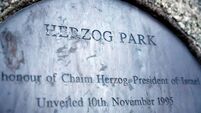Special Report: Leaving Certificate Results

Colleges to widen use of bonus points
Colleges are planning to widen the use of bonus points to other subjects as they have resulted in another record number of Leaving Certificate students sitting higher-level maths.
As almost 57,000 school-leavers pick up their results this morning, one of the main talking points will be the rise to 27% in the proportion of maths students choosing the honours paper. It has risen from 16% of all students in 2011, after colleges began awarding 25 bonus points for anybody who passes higher-level maths to encourage greater engagement with the subject.
While that improvement has been welcomed by industry figures and Education Minister Jan O’Sullivan, she will also examine the fact that the proportion of students who failed honours maths has nearly doubled in two years, limiting chances for college courses for some of them. While low as an overall proportion, the 650 students in that situation make up 4.5% of all higher-level maths candidates, up from 2.3% in 2012.
“As this is an emerging trend, it will be closely monitored in 2015 and 2016,” her spokesperson told the Irish Examiner.
In a progress report on plans to reform third-level entry, a task group of the Irish Universities Association is recommending further exploration of awarding some bonus points based on the relevance of a subject to a course for which a student has applied, as long as it does not force early specialisation at school.
“Bonus points for higher-level mathematics is an effective incentive, which should be reviewed and refined in the light of experience to date,” the task group said.
It also suggests addressing the question of whether it is right to give students with an aptitude for maths an advantage when selecting entrants to arts and humanities courses.
Ms O’Sullivan, who is in the role just over a month, said she looks forward to final reports from this and other groups on initiatives to reduce the stress on students making the transition from school to college.
For 45,700 who get their results today, further anxiety lies ahead until Monday’s release of college offers through the CAO. But one student should have their choice of courses, having scored nine higher-level A1s. Twelve others scored top grades in eight subjects.
The introduction of bonus points has influenced increases in entry requirements for hundreds of degrees in recent years, but demand and the results of all applicants for each course also play a role.
Employers’ body Ibec welcomed the increased higher-level maths uptake and said the fact that 72% got an honours (A, B, or C) grade suggests more students are capable of studying the subject at higher level.
However, it is concerned at the potential for foreign investment competitiveness due to declines in numbers taking French and German over the last decade; they are down to 49% and 13%, respectively, of the 54,025 students who took the traditional Leaving Certificate.
The State Examinations Commission is also sending results of 2,965 Leaving Certificate Applied students today, up slightly on last year, but down from more than 3,350 in 2010.
Bonus points pay off as 27% sit higher level maths
A record 27% of Leaving Certificate maths students took the higher level exam this year as the effects of bonus college-entry points continue.
But 4.5% of the 14,326 school-leavers who took the honours papers in June have failed the subject, nearly double the proportion who did so in 2012. Most of those, 3.8%, got an E grade, just short of passing, up from 2.9% last year and 1.8% in 2012.
Some of these 645 students now risk not getting into one or more third-level courses they had applied for, if those degrees have higher or ordinary level maths as a minimum entry requirement. Had those students got a high-grade at ordinary level maths, they might have been eligible, once they had the required CAO points.
The policy to award 25 additional points in the Central Applications Office calculation of Leaving Certificate points was adopted by third-level colleges in 2012. The move followed the slump in the proportion of students taking higher level exams in the subject to below one-in-six, largely due to the difficulty associated with the subject.
The number jumped to 22% in the first year of the use of bonus points, then to 25.6% last year, and now to 27.3%, a figure likely to be welcomed by Government, employers and other sectors.
The latest increase was largely expected, based on State Examinations Commission data earlier this year for predicted entry levels, although close to 3,000 decided against the higher level and taking ordinary level instead on exam day in June.
However, while the rise will be largely welcomed, there may also be anxiety about the pressure the competition for college places appears to put on some students to attempt higher level maths.
In 2012, just 2.3%, around 256, of those who did so got an E grade or lower, rising to 3.3% in 2013.
But that figure has nearly doubled in just two years, possibly as a result of some students having a go at papers for which they might not have the ability, in order to secure 25 extra CAO points for passing.
“We obviously welcome any uptake in higher level maths but the question of any increase in numbers failing it would need to be addressed,” said National Association of Principals and Deputy Principals director Clive Byrne.
In order to accommodate some students who may not have reached the required maths standard for particular courses, a number of third-level colleges offer a second-chance exam where they can demonstrate their ability to follow the course they are otherwise eligible for with their overall Leaving Certificate results.
Cork Institute of Technology holds its second-chance maths exam next Tuesday.
At NUI Galway, a special entrance exam has been provided for more than 20 years for students who did not get the minimum higher level C3 in maths needed for entry to its general engineering degree. Students who pass next Wednesday’s exam, even if they sat ordinary level maths for the Leaving Certificate, will get a round 2 CAO offer for entry to the course.
“Every year we see a number of promising students who perform poorly on the day of the Leaving Cert exam. Our special entrance maths exam provides these students with a second opportunity to demonstrate that they have reached the necessary standard in maths,” said Gerry Lyons, dean of engineering and informatics at NUIG.
THE CHANGES - Higher maths and Irish see numbers rise

There were no major changes in overall performance of Leaving Certificate students in most subjects this year, but there were some notable increases in the numbers taking some subjects or choosing higher level over ordinary level.
The State Examinations Commission reports that 56,990 students sat the exams in June and will get their results today. That is up 2.4% on last year and includes almost 3,000 who took the Leaving Certificate Applied programme.
For honours Irish and maths, recent changes have resulted in big growths in student numbers.
Among the 45,268 to take an exam in Irish, 18,134 took the subject at higher level. While this accounts for just 40% of overall numbers taking papers in Irish, it is up from 38% last year and 32% in 2011.
The numbers have not seen any consequent major changes in overall performance, with 89% getting an honours grade (A, B, or C) and 11% passing with a D.
The change in weighting of marks for the oral component — from 25% to 40% — has been key to the swing to higher level. Just over 51% of all Irish exam candidates took ordinary level in June (down from 53% last year) and 8% did foundation level.
Education Minister Jan O’Sullivan noted increases of 11% and 9% in the numbers sitting papers in physics and Spanish, respectively.
There was a 3% jump in numbers taking Leaving Certificate history to almost 12,200, bringing the subject above home economics in popularity. But numbers taking geography are continuing to fall, even though it remains one of the most popular optional subjects, topped only by biology and French.
Although German and French numbers are up year on year, employers’ group Ibec raised concern that the proportion of students sitting them (13% and 49%, respectively) are lower than a decade ago.
“We continue to see significant numbers of unfilled job vacancies that require modern languages. It’s vital that we don’t find ourselves at a competitive disadvantage when it comes to selling into global markets and attracting foreign investment,” said Ibec head of education policy, Tony Donohoe.
The American Chamber of Commerce Ireland said the introduction of bonus points for maths has resulted in an almost 70% rise in students sitting the higher level paper, and additional ways should be sought to encourage students to pick subjects that will support their future careers.
“New proposals that are being considered, such as providing more points for subjects based on their relevance to third-level courses, and expanding the range of grades for which points are awarded, are welcome developments,” said chamber chief executive Mark Redmond.
He welcomed increases in numbers studying science, technology, engineering, and maths subjects, which include the rise to 7,177 from fewer than 6,500 candidates for physics, among whom 12% more than last year took higher level.
The 8,604 getting results in chemistry today is nearly 450, or 5.5%, more than a year ago.
Those figures were described by Teachers’ Union of Ireland president Gerry Quinn as encouraging, at a time when such subjects have been identified as key to the country’s skills requirements. But he also flagged high failure rates in science subjects — 7%, 8%, and 9%, respectively, of students of higher-level biology, physics, and chemistry.
Ms O’Sullivan thanked teachers and education staff for their help preparing students for exams and said those getting results today would remember their positive impact in 10, 20, or 30 years.
Unions were critical of the impact of Department of Education cuts to schools, around which teachers have been working with students.
“Despite the evidence that investing in education is vital to sustainable economic recovery and to young people’s future lives, today’s school leavers have experienced larger class sizes, less one-to-one time with their teachers, less subject choice and reduced access to guidance counselling, and a range of other in-school resources and services,” said Association of Secondary Teachers Ireland president Philip Irwin.
[comment]
APPLIED OPTION - Increase in numbers taking applied route


There is a slight increase in numbers taking Leaving Certificate Applied this year after declines over recent years.
The Leaving Certificate Applied can not be counted towards third-level courses in the CAO, but it represents a major achievement for the thousands who take part each year, many of whom might otherwise have been at risk of dropping out of school.
Rather than A, B, C, and similar grades for traditional Leaving Certificate subjects, students are awarded based on credits accumulated over the two years of the programme, including those earned at written exams last June. The subjects include English and communication, social education, European languages, craft and design, active leisure studies, horticulture, hair and beauty, and mathematical appliances.
A distinction is awarded for 85% to 100%, merit for 70% to 84%, and pass for 60% to 69%.
Over the last number of years, despite falls to the proportion of young people dropping out of school, numbers taking the Leaving Certificate Applied option have fallen.
Between 2010 and 2013, for example, they dropped by 16%, from 3,358 to 2,810, leading to claims by the Teachers’ Union of Ireland that budgetary cutbacks and staffing changes were forcing many schools to drop the programme.
The State Examinations Commission data for 2014 entrants show that 2,965 students completed Leaving Certificate Applied this year. That is a 5.5% increase on last year’s participation rate, more than double the 2.4% increase in overall number of Leaving Certificate students recorded this year.
Just over one in five students achieved a distinction, up slightly on last year’s proportion, and 50.5% receive a merit this morning.
The programme is taken as an optional addition to the traditional curriculum, and is available in around two-thirds of the country’s 730 second-level schools. It is based on academic and experiential work, and students take a range of established Leaving Certificate subjects.
But they also take a formal and practical programme called the links modules. These consist of compulsory work experience and enterprise activity, together with personal and vocational exploration, and substantial use of information technology.
The 60.6% of this year’s vocational programme students to achieve a distinction or merit is up from 59.4% last year, but compares with almost 64% who did so in 2012.
Although fewer than the 16,400 vocational candidates in 2011, this year’s overall participation figure is slightly higher than the 15,091 who completed the programme in 2009.
NERVOUS TIME - Waiting game begins for first college offers

For more than 45,700 of those getting Leaving Certificate results today, there will be another five days of nervous waiting.
The Central Applications Office (CAO) is already processing the results forwarded by the State Examinations Commission in respect of those who applied for college courses earlier this year.
While they are not the only category of applicants, the vast majority of an estimated 46,000 places to be filled through the CAO will be offered from next Monday and over the following weeks on foot of today’s results.
While overall applications climbed to just under 78,000 — from 76,121 last year — the individual cut-off entry points for each course will be decided by demand; by the Leaving Certificate results of those who applied; and by any changes to the number of available places.
There were increases in demand for honours degrees in business, engineering and teacher- training this year, while slight falls were seen in arts and science degrees as first preferences.
The CAO offers should arrive by post next Monday morning, but applicants can check their emails or go online to see if they have been offered a course from 6am.
Despite plans to reduce the numbers of courses on offer; broadening many programmes instead to general entry; and allowing students specialise after first-year, there are almost 40 more for applicants to choose from this year. The 942 honours (level 8) degrees and 471 ordinary degree and higher certificate (level 7 & 6) courses compare with just 583 and 312, respectively, a decade ago.
As well as 2014 Leaving Certificate students, the CAO received applications from 12,461 over-23s applying as mature students, 19,600 with further education qualifications, almost 8,000 with previous higher education attendance, and 2,094 with A-level results from Northern Ireland or Britain.
Many students may be counted under more than one category, and some mature or further education graduates have already been offered places reserved for such applicants.
RECHECKING - Students get opportunity to view papers before appeal

There will be a chance later this month to see the exam paper for any subject, in which a student is not happy with his or her grade, before deciding whether to appeal the result.
Last year, more than 9,000 individual grades in a range of Leaving Certificate subjects were re-marked after students made an appeal.
Higher level English (1,528), biology (1,026) and maths (681) were the most-appealed subjects in 2013. Just under 1,647 appeals, 18% of the total, resulted in upgrades, with around 300 students each year earning a CAO offer on foot of the improved result or results.
Although it is not necessary before making an appeal, it is advisable to arrange to view a marked script at the school before deciding whether or not to seek a recheck by the State Examinations Commission.
The SEC will have sent the marked written scripts for many of the more common subjects back to schools to ease the logistics of making available those which students ask to view. But it will also send back any others for which a viewing is requested.
Such requests have to be received by the SEC by next Tuesday — the day after Central Applications Office round 1 offers are made — so anybody who is dissatisfied with a particular grade should think about doing so at this stage. It is worth remembering too that, while minimum CAO points for a significant proportion of courses remain quite similar to those of the previous year, there is a possibility that increased demand or restrictions on places could see points jump for any individual college programme.
Appeals apply only to the papers from the written exams in June, but practical and oral tests associated with any appealed subject will also be fully re-marked.
All students who sat their exams at a school must apply for the free viewing service through their schools by Tuesday next. This will allow for the scripts to be made available for viewing, also at the school on either Friday, August 29, or Saturday, August 30.
In the event that there is a clear inconsistency between the total mark awarded and the grade given, there might not be a need for a full appeal. Instead, such discrepancies can be detailed in a form from the organising superintendent, who will send it back with the exam script to the SEC for immediate attention.
The errors covered by this procedure include mistakes by the examiner who corrected a paper transcribing the overall mark from the answer book to the marking sheet, or by SEC administrative staff entering the data from the marking sheet into the exams database.
Otherwise, with the assistance preferably of a teacher of the subject, students should go through the exam paper carefully to see if there are places where the examiner may have not followed the marking scheme, which will also be made available.
For a €40 fee, refundable if an upgrade results, the paper and any other components will be remarked if an appeal is lodged, but it will be mid-October before the outcome is made known to students who appeal.












